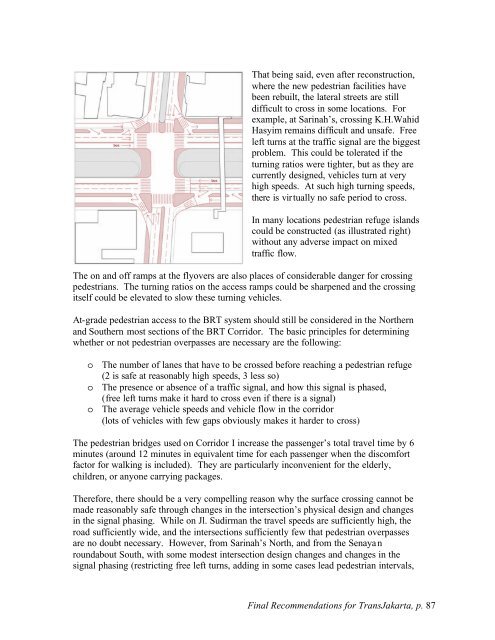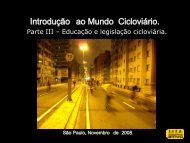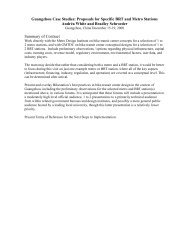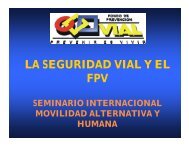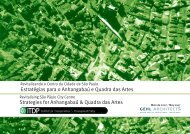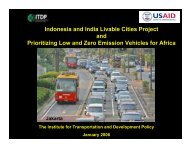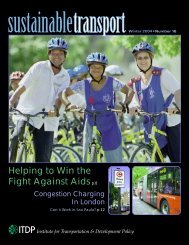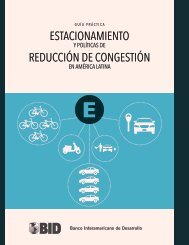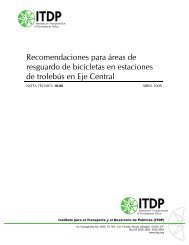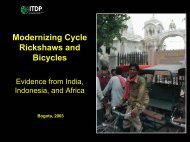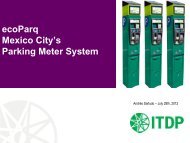Making TransJakarta a World Class BRT System - ITDP | Institute for ...
Making TransJakarta a World Class BRT System - ITDP | Institute for ...
Making TransJakarta a World Class BRT System - ITDP | Institute for ...
You also want an ePaper? Increase the reach of your titles
YUMPU automatically turns print PDFs into web optimized ePapers that Google loves.
That being said, even after reconstruction,<br />
where the new pedestrian facilities have<br />
been rebuilt, the lateral streets are still<br />
difficult to cross in some locations. For<br />
example, at Sarinah’s, crossing K.H.Wahid<br />
Hasyim remains difficult and unsafe. Free<br />
left turns at the traffic signal are the biggest<br />
problem. This could be tolerated if the<br />
turning ratios were tighter, but as they are<br />
currently designed, vehicles turn at very<br />
high speeds. At such high turning speeds,<br />
there is virtually no safe period to cross.<br />
In many locations pedestrian refuge islands<br />
could be constructed (as illustrated right)<br />
without any adverse impact on mixed<br />
traffic flow.<br />
The on and off ramps at the flyovers are also places of considerable danger <strong>for</strong> crossing<br />
pedestrians. The turning ratios on the access ramps could be sharpened and the crossing<br />
itself could be elevated to slow these turning vehicles.<br />
At-grade pedestrian access to the <strong>BRT</strong> system should still be considered in the Northern<br />
and Southern most sections of the <strong>BRT</strong> Corridor. The basic principles <strong>for</strong> determining<br />
whether or not pedestrian overpasses are necessary are the following:<br />
o The number of lanes that have to be crossed be<strong>for</strong>e reaching a pedestrian refuge<br />
(2 is safe at reasonably high speeds, 3 less so)<br />
o The presence or absence of a traffic signal, and how this signal is phased,<br />
(free left turns make it hard to cross even if there is a signal)<br />
o The average vehicle speeds and vehicle flow in the corridor<br />
(lots of vehicles with few gaps obviously makes it harder to cross)<br />
The pedestrian bridges used on Corridor I increase the passenger’s total travel time by 6<br />
minutes (around 12 minutes in equivalent time <strong>for</strong> each passenger when the discom<strong>for</strong>t<br />
factor <strong>for</strong> walking is included). They are particularly inconvenient <strong>for</strong> the elderly,<br />
children, or anyone carrying packages.<br />
There<strong>for</strong>e, there should be a very compelling reason why the surface crossing cannot be<br />
made reasonably safe through changes in the intersection’s physical design and changes<br />
in the signal phasing. While on Jl. Sudirman the travel speeds are sufficiently high, the<br />
road sufficiently wide, and the intersections sufficiently few that pedestrian overpasses<br />
are no doubt necessary. However, from Sarinah’s North, and from the Senayan<br />
roundabout South, with some modest intersection design changes and changes in the<br />
signal phasing (restricting free left turns, adding in some cases lead pedestrian intervals,<br />
Final Recommendations <strong>for</strong> <strong>TransJakarta</strong>, p. 87


